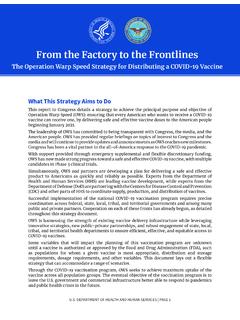Transcription of 2019 UK Greenhouse Gas Emissions, Final Figures
1 Responsible statistician: Christopher Waite Email: Media enquiries: 020 7215 1000 Public enquiries: 020 7215 8285 Next publication: February 2022 2019 UK Greenhouse Gas Emissions, Final Figures 2 February 2021 National Statistics In 2019, net territorial emissions in the UK of the basket of seven Greenhouse gases covered by the Kyoto Protocol were estimated to be million tonnes carbon dioxide equivalent (MtCO2e), a decrease of compared to the 2018 figure of million tonnes and lower than they were in 1990.
2 Carbon dioxide made up around 80% of the 2019 total. UK territorial Greenhouse gas emissions, 1990-2019 The decrease in Greenhouse gas emissions from 2018 was mainly caused by reductions in emissions in the energy supply sector, down ( MtCO2e). This was driven by the continued decrease in power station emissions due to the change in the fuel mix for electricity generation, in particular a reduction in the use of coal. Emissions from energy supply are now lower than they were in 1990. Emissions from transport fell by ( MtCO2e) in 2019, their second year of falls having previously risen since 2013.
3 Despite this transport remains the largest emitting sector, responsible for 27% of all Greenhouse gas emissions in the UK. Transport emissions are only lower than in 1990, as increased road traffic has largely offset improvements in vehicle fuel efficiency. What you need to know about these statistics: This publication provides the latest estimates of 1990-2019 UK territorial Greenhouse gas emissions, meaning emissions that occur within the UK s borders. They are presented in carbon dioxide equivalent units (CO2e) throughout this statistical release and cover the Kyoto basket of seven Greenhouse gases: carbon dioxide (CO2), methane (CH4), nitrous oxide (N2O), hydrofluorocarbons (HFC), perfluorocarbons (PFC), sulphur hexafluoride (SF6) and nitrogen trifluoride (NF3).
4 We made a major methodology change to the estimates this year to better represent emissions from peatlands, which combined with other changes has led to a large upward revision to our emission estimates of between 10 and 17 MtCO2e each year from 1990 onwards compared to those published last year. Further details are given on page UK Greenhouse Gas Emissions, Final Figures 2 Contents Introduction _____ 3 2019 total Greenhouse gas emissions _____ 6 UK performance against emissions reduction targets _____ 7 Domestic Targets _____ 7 International Targets _____ 8 Emissions Trading _____ 11 Emissions by sector _____ 13 Transport _____ 13 Energy supply _____ 15 Business _____ 17 Residential _____ 18 Agriculture _____ 19 Waste management _____ 19 Industrial processes _____ 20 Public _____ 21 Land use, land use change and forestry (LULUCF)
5 _____ 22 International comparison _____ 24 Emissions from UK-based international aviation and shipping bunkers _____ 26 Revisions from provisional estimates of Greenhouse gas emissions _____ 27 Revisions to the UK s Greenhouse Gas Inventory _____ 28 Accompanying tables _____ 34 Technical information _____ 35 Methodology for producing Greenhouse gas emissions estimates _____ 35 Estimating emissions on a temperature adjusted basis _____ 36 Uncertainties _____ 37 Further information _____ 38 Future updates to these statistics _____ 38 Related publications _____ 38 Revisions policy _____ 39 Uses of these statistics _____ 39 User engagement _____ 40 National Statistics designation _____ 40 Pre-release access to statistics _____ 40 Contact _____ 41 2019 UK Greenhouse Gas Emissions, Final Figures 3 Introduction This publication provides the latest annual estimates of UK territorial Greenhouse gas emissions from 1990-2019.
6 The geographic coverage of this report is UK only unless stated otherwise. The Figures in this statistical release are used as the basis for reporting against UK Greenhouse gas emissions reduction targets and provide information for users on the drivers of emissions trends since 1990. Emissions are estimated following the guidance set out by the Intergovernmental Panel on Climate Change (IPCC)1, as required for the UK s submissions to the United Nations Framework Convention on Climate Change (UNFCCC) each year.
7 The estimates present emissions on a territorial basis, so only include emissions which occur within the UK s borders. They therefore exclude emissions from UK businesses and residents that occur abroad, including from international aviation and shipping, and any emissions embedded within the supply chain of manufactured goods and services imported into the UK (while including emissions that occur in the UK resulting from exported goods and services). Two additional approaches to estimating UK emissions are also published and the Office for National Statistics (ONS) has published an article that compares these different measures of the UK s Greenhouse gas emissions in more detail.
8 The alternative measures are: ONS publishes emissions on a residency basis in the UK Environmental Accounts. The Figures represent emissions caused by UK residents and businesses whether in the UK or abroad, but exclude emissions within the UK which can be attributed to overseas residents and businesses. The Department for Environment, Food and Rural Affairs (Defra) publishes the UK s carbon footprint. This estimates emissions on a consumption basis, meaning it covers emissions associated with the consumption of goods and services by households in the UK.
9 It includes estimates of emissions associated with each stage of the supply chain for those goods and services, regardless of where they occur, while excluding emissions occurring in the UK that are associated with the consumption of goods and services by households outside the UK. Figure 1 shows how the estimates of UK territorial emissions in this publication compare to the most recent estimates of UK emissions on a residency and a consumption basis. The estimates are not directly comparable as there are differences in definitions and methodologies, for example the consumption-based estimates do not include F gases, and both the consumption-based and residency-based estimates do not incorporate the latest methodology changes made to the territorial estimates.
10 However, this does give a good indication of the relative sizes and trends in each of these estimates and it can be seen that the UK s consumption-based emissions are considerably higher than its territorial emissions and followed a different trend over this period, peaking in 2007 and not falling as far as the territorial and residency-based estimates have since 1990. 1 2006 IPCC Guidelines for National Greenhouse Gas Inventories: ; 2013 Supplement to the 2006 IPCC Guidelines for National Greenhouse Gas Inventories: Wetlands (Wetlands Supplement).














